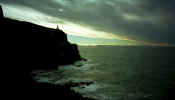Sea Lions, Sheep and a Very Steep Street
Wednesday 28 June – Saturday 1 July 2000
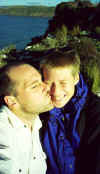 And
so we left Auckland on the day we had planned, but instead of heading for the
international departures, we were dropped off at the domestic terminal for a
short flight south to Dunedin. Our
plan was to hire a car there and drive south along the east coast then up along
the west coast before cutting back across the island to end up in Christchurch,
where we would catch a flight back to Auckland. Knowing that we would be
facing an even colder climate on the South Island, we made some emergency
purchases prior to our departure, acquiring a couple of new woolly
jumpers, scarves and gloves as well as a few pairs of thick socks.
And
so we left Auckland on the day we had planned, but instead of heading for the
international departures, we were dropped off at the domestic terminal for a
short flight south to Dunedin. Our
plan was to hire a car there and drive south along the east coast then up along
the west coast before cutting back across the island to end up in Christchurch,
where we would catch a flight back to Auckland. Knowing that we would be
facing an even colder climate on the South Island, we made some emergency
purchases prior to our departure, acquiring a couple of new woolly
jumpers, scarves and gloves as well as a few pairs of thick socks.
Dunedin was our entry point onto
the South Island and proved to be a beautiful city. Reminiscent of Scotland’s Edinburgh (indeed Dunedin is
Celtic for Edinburgh), it was founded by Scottish settlers and has a statue of
Robert Burns guarding its city centre. It
still retains much of its old Victorian architecture and, in true Scottish
tradition, even boasts its own whisky distillery. Finding another fine B&B establishment, we booked in for
a couple of days and after a morning of sightseeing around the city centre,
spent the rest of our time focusing on some of the scenic highlights on offer
around the Otago Peninsular.
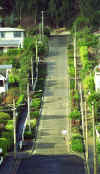 First,
however, we wanted to check out something that had caught our eye in the
guidebook: Baldwin Street, listed in the Guinness Book of Records as the
world’s steepest street. And
steep it is. Eric can vouch for this first hand having decided to run up
(and down) it just to check out the gradient, a mere 1 in 1.266!
Apparently, fit runners can do the return trip in around 2 minutes.
Needless to say Eric took somewhat longer,
First,
however, we wanted to check out something that had caught our eye in the
guidebook: Baldwin Street, listed in the Guinness Book of Records as the
world’s steepest street. And
steep it is. Eric can vouch for this first hand having decided to run up
(and down) it just to check out the gradient, a mere 1 in 1.266!
Apparently, fit runners can do the return trip in around 2 minutes.
Needless to say Eric took somewhat longer, but thankfully is still with us to tell the tale.
but thankfully is still with us to tell the tale.
To the east of Dunedin is the
Otago Peninsula, a small piece of land jutting out into the Pacific Ocean on
which is one of the most accessible wildlife areas on the entire South Island.
At Taiaroa Head at the end of the peninsula is the only northern royal
albatross colony in the world close to human habitation.
The birds arrive at the nesting site in September, mate in October, lay
their eggs in November and then incubate them until January when the chicks
hatch. Between March and September
(we were there in late June), the parents leave their chicks while collecting
food, returning only for feeding. They
can spend as little as a tenth of their long life actually on land, being able
to stay aloft for days at a time, ranging almost effortlessly on the prevailing
winds.
There is no such thing as a
guarantee that you will get to see any albatross at the time of year we were
there, but we decided to drive up to the visitors center anyway to read up on
these fascinating birds and check out the view. As we stood on the edge of the cliff looking out to sea at
the many white birds circling above us, we wondered how we could tell which, if
any, were albatross. We knew we were
looking for something with a wide wingspan but even so, the birds we were
looking at seemed to us pretty impressive.
With that, the most enormous bird flew over us and it was obviously no
seagull.
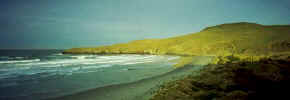 As
if one bird spotting coup of the day was not enough, we were back down the hill
for another, this time penguins. These
were not just any penguins, however. These
were yellow-eyed penguins, one of the rarest penguin species in the world.
The Yellow Eyed Penguin Reserve has won many awards for its conservation
efforts and there set up is certainly an impressive one.
The reserve has been set up in the dunes behind a beach in a secluded
bay. Tunnels have been dug and
camouflaged to allow visitors to observe the birds in their natural habitat
undisturbed.
As
if one bird spotting coup of the day was not enough, we were back down the hill
for another, this time penguins. These
were not just any penguins, however. These
were yellow-eyed penguins, one of the rarest penguin species in the world.
The Yellow Eyed Penguin Reserve has won many awards for its conservation
efforts and there set up is certainly an impressive one.
The reserve has been set up in the dunes behind a beach in a secluded
bay. Tunnels have been dug and
camouflaged to allow visitors to observe the birds in their natural habitat
undisturbed. 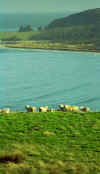
Having never seen any kind of
penguin in their natural habitat, it was a moving experience watching them come
in from the sea in the late afternoon after spending the day out at sea feeding.
As they waddle out of the water up onto the beach, they greet one another,
then preen themselves and dry off their feathers before waddling up into the
sand dune where their hives are located. If
it were not for the over-zealous people trying to get the ultimate snap shot and
pushing you out of their way in the process, this would be a wonderful place to
observe the penguins closely and see how they interact with one another.
Nevertheless, it’s a pretty special way to catch your first sighting of
them in the wild.
From Dunedin, we drove south,
following the road along the east coast. The
tourist guides call this the Southern Scenic Route and the scenery truly is
breathtaking. There was everything
from rolling green pastures to native forests and mountainous ranges.
The views down to the coves and beaches from the cliff tops were
stunning. The forests were teeming
with spectacular waterfalls and everywhere there seemed to be an abundance of
wildlife.
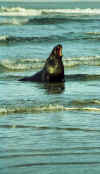
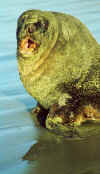 Our
first stop was a region known as the Caitlins, and so much was there to see and
do here we ended up spending two full days.
One of the two main highlights (among several fantastic treks through
forests to see waterfalls) was our encounter with a group of sea lions early one
morning as we walked the length of a long, deserted beach.
They were far from friendly, but we were able to get amazingly close to
them before they would bark menacingly and threaten to charge, and we sat for
hours on the dunes watching them just below us on the beach frolicking in the
sand.
Our
first stop was a region known as the Caitlins, and so much was there to see and
do here we ended up spending two full days.
One of the two main highlights (among several fantastic treks through
forests to see waterfalls) was our encounter with a group of sea lions early one
morning as we walked the length of a long, deserted beach.
They were far from friendly, but we were able to get amazingly close to
them before they would bark menacingly and threaten to charge, and we sat for
hours on the dunes watching them just below us on the beach frolicking in the
sand.
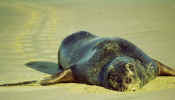
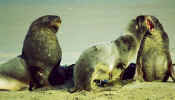
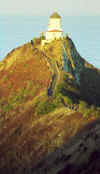
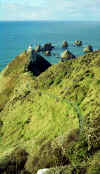 The
other highlight was Nugget Point. At
the tip of the headland is a lighthouse and leading off from the peninsular a
line of tiny islands that seem to fall off the horizon.
Way below at the bottom of the cliff we could make out fur seals basking
on the large rocks as well as penguins and a vast array of different species of
birds ducking and diving in the coastal breezes.
The views were stunning, particularly as the day began to come to a
close and the sun started to set over the wide expanse of sea beyond the
lighthouse. It was a magical place.
The
other highlight was Nugget Point. At
the tip of the headland is a lighthouse and leading off from the peninsular a
line of tiny islands that seem to fall off the horizon.
Way below at the bottom of the cliff we could make out fur seals basking
on the large rocks as well as penguins and a vast array of different species of
birds ducking and diving in the coastal breezes.
The views were stunning, particularly as the day began to come to a
close and the sun started to set over the wide expanse of sea beyond the
lighthouse. It was a magical place.
